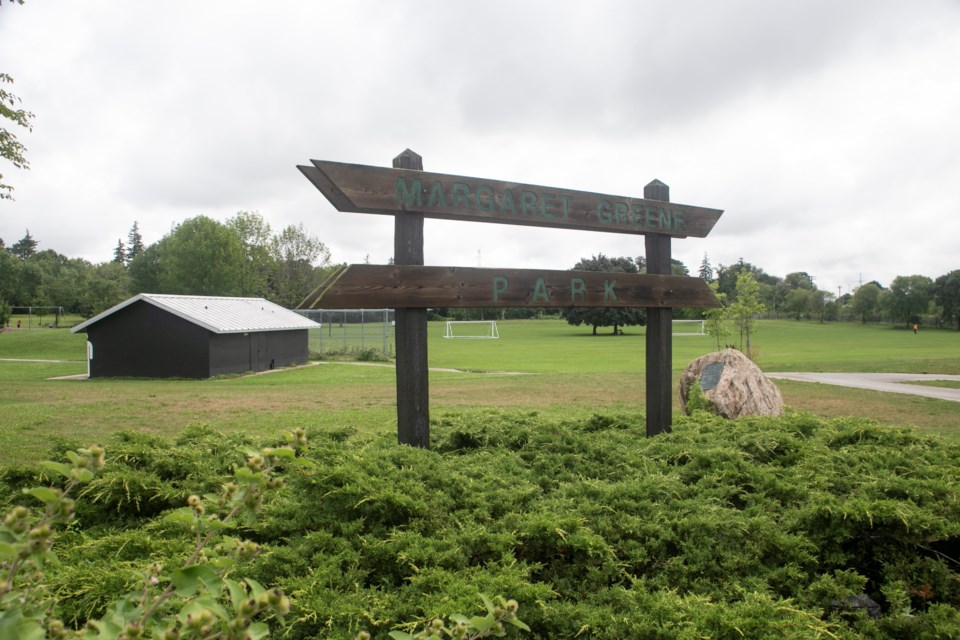A chunk of Margaret Greene Park could be off limits for recreational use in the years to come, as city staff look to create a stormwater management pond there.
That’s part of the city’s updated stormwater management master plan which received unanimous approval from council’s committee of the whole on Tuesday. Ratification by council is expected later this month.
“We don’t build them to be recreational facilities,” deputy CAO Jayne Holmes said of stormwater management ponds in response to a question from Coun. Phil Allt about community use.
Skating, in particular, on frozen ponds is discouraged because the water’s salt content makes it unsafe, added fellow deputy CAO Colleen Clack-Bush.
Coun. Linda Busuttil, whose ward includes Margaret Greene Park, asked whether new parkland would be bought to replace the lost recreational space at Margaret Greene.
“We wouldn’t look for offsetting lands per se, it’s more of an integrated feature of the park itself,” responded Terry Gayman, the city’s general manager of engineering and transportation services
Though recreational uses of stormwater ponds are discouraged, Clack-Bush noted they’re considered park space when it comes to the city’s obligation to meet the needs of residents.
“We have a number of naturalized areas and stormwater ponds throughout our park inventory,” Colleen Clack-Bush said.
Stating the pond plan was difficult to find, Busuttil questioned when and how nearby residents will be involved.
“Parkland is golden,” she said, calling for public engagement before major details are determined for projects that impact neighbourhoods, such as the pond plan. “Even un-programmed park space is of value to the community.”
City staff recommends the creation of 15 new stormwater management ponds throughout the city, including 11 at parks. The preferred option in most cases is for underground water storage.
However, surface ponds are proposed for Margaret Green Park, the Guelph Junction Railway land on Stevenson Avenue, city-owned land at 606 Massey Rd. and at the end of Industrial Street along York Road (site of the former Royal City Jaycees Park).
“The report itself identifies opportunities for end-of-pipe solutions,” explained Gayman, noting the next step is to evaluate those opportunities. “When a specific location is identified, like a park, staff will then go into pre-design processes, collect the right information, then go out and engage the community.”
Engagement only happens once a project has received budget approval, he noted. At that point, discussion will focus on the precise location, size, safety features and more.
Asked why a surface pond is recommended for Margaret Greene rather than an underground one, Gayman explained surface ponds cost less than subsurface ponds and offer habitat for wild species.
The committee also threw its unanimous support behind an updated water and wastewater master plan during Tuesday’s meeting.
Intended to keep up with the demands of population growth, the updated plans come with a combined cost of more than $480 million for infrastructure and water system enhancements by 2051.
“The price tag is not for the faint of heart,” said Coun. Dominique O’Rourke during Tuesday’s committee meeting. “At the end of the day, city-wide, these plans are looking at climate change mitigation and adaptation. They’re a necessary engineering function.”
While much of that work is expected to be paid for through development charges, local water users will be on the hook for whatever isn’t covered.
It’s unknown how much that will be.
“The overarching study objective is to develop a long-range plan for efficient distribution of water and collection of wastewater in the existing condition and to support growth to 2051+, while considering the effects of climate change on system design,” states the water and wastewater report. “Water and wastewater projects have been identified across the entire city.”
Water and wastewater system enhancements are pegged at $180.2 million, while stormwater management is estimated at $300.1 million.
If approved by council, the combined annual spending would be in the range of $17.8 million, though the reports note the precise amount would vary year to year depending on the prioritization of projects.
Recommendations include the installation of new watermains, improvements to pumping facilities, replacement of storage elements at the end of their service life, new sewer lines, new stormwater management facilities, restoration projects for stream erosion sites and more.
